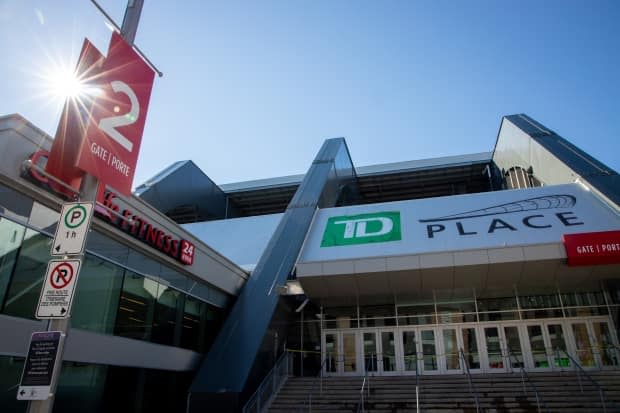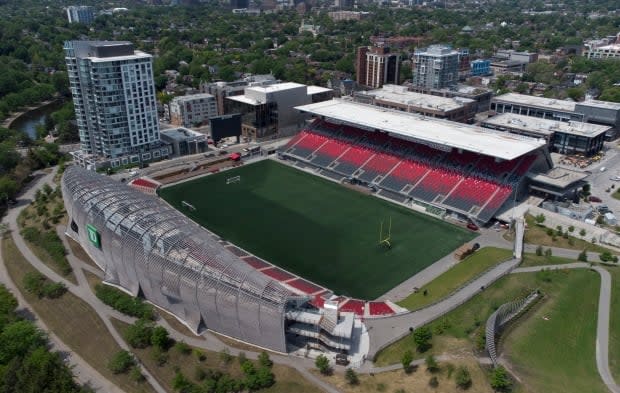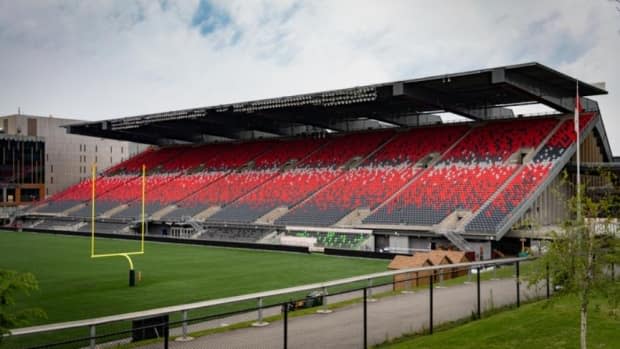Lansdowne's north-side stands a monument to false economies

The reports of the north-side stands at Lansdowne paint a less-than-ideal picture.
The wonky 1960s-era design of the stadium stands attached underneath the TD Place arena, known as the Civic Centre, has resulted in load-bearing issues — people cannot be in the stadium stands and in the arena underneath simultaneously if there's any chance of snow.
The arena's ventilation is subpar, and even when the system is running at full-strength, fans complain of being cold in their seats. There are mould issues. The suites are closed because they no longer meet modern-day building codes. The list continues.
So it's no surprise that the city and its private partners in Lansdowne — the Ottawa Sports and Entertainment Group (OSEG) — are now considering tearing it all down.
Except here's the thing: these sorry details are from reports that are more than a decade old.
This week, Mayor Jim Watson surprised reporters somewhat by openly admitting regret that the north-side complex wasn't rebuilt when Lansdowne underwent its overhaul less than a decade ago.
"We probably, in hindsight, should have done the north-side stands-Civic Centre renovation at the same time," he said.
Well, no kidding.
In addition to all the engineering-type problems that city officials already knew about, there was the general fact that the north stands had been built in 1967. Virtually no events centre meets current entertainment industry standards after 40 or 50 years.
The people who pushed for this deal knew the drawbacks of the north-side stands. Or at least they should have.
So why weren't the stands rebuilt?
According to Watson, the main two reasons were that the north-side stands "could last another decade or so" and "one of financing."

The politics of good enough
Let's take the mayor's first point, that the stands were OK.
Sure, they're going to last. They are a giant complex of steel and concrete, which are inspected regularly to make sure they are structurally sound.
But every year, the complex becomes less and less appealing, which everyone knew more than a decade ago. Soon after OSEG took over operations there, it had to spend $23 million to fix the Civic Centre's spongy roof — and it still leaks.
Of course we want city officials to spend public money wisely. But prudent spending doesn't always mean less spending. (Prime example: Our "Chevy" versus "Cadillac" LRT system, as per the mayor's description. Apologies to Chevy.)
Good enough is not often recipe for triumph. There were a lot of question marks surrounding the Lansdowne plan, one of which was how to attract enough people to the site.
By not addressing the clear drawbacks of the main sports and entertainment assets, the city didn't do all that it could have to set the stage for success. And now we're looking at paying for it anyway, a decade after losing out on who knows how many opportunities.
Consider this: the arena is so outdated, it doesn't meet the technical specs required to host the national junior hockey championships.

The mayor is fond of saying that the detractors of the Lansdowne redevelopment preferred the crummy asphalt parking lot that was there in the before times.
This is, of course, not true.
More to the point, while "better than a parking lot" may be achievable, it's an awfully low bar.
Cost of stands in the 9-figures
Now, the money.
When the city — which owns the Lansdowne Park site including the stadium and Civic Centre complex — finalized its highly complex partnership with OSEG in 2012, council committed to spending $135 million on the stadium. Almost $100 million of that went to replacing the condemned south-side stands.
How much would it have cost to replace the north stands, complete with a new arena? There are no public records that show it had been seriously contemplated, but it would have been more expensive than its south-end counterparts.
If we had spent time then re-imagining the north stands, perhaps Lansdowne — which currently needs an additional one million visitors to be sustainable long-term — would have been more successful.
Or, perhaps, if taxpayers had known the full cost, the project would never have gone ahead at all.
Given the intense controversy around the Lansdowne deal, would it ever have passed if the cost was, say, $250 million instead of $135 million?
It's pretty likely that political consideration entered the calculation when folks decided not to replace the north-side stands.
But not only was that a false economy — if this project goes ahead, we'll be paying a lot more now, not to mention the disruption the construction will cause — it's not transparent governance.
Selling a so-called vision with an artificially lower price tag, knowing that taxpayers will probably have to cough up more later on is what politicians often do.
As well, looking back, if the city had suggested replacing both sets of stands — akin to replacing the entire stadium complex — it would probably have resulted in a larger discussion about whether the Glebe was the right place for a sports stadium, or whether the municipality should even own a stadium.
Vocal critics were trying to make those points anyway, but as long as champions of the plan could argue the stadium was only being refurbished, those wider discussions were kept effectively at bay.
It's no way to make a building decision, but here we are seven years later, contemplating a big outlay that's corrective rather than creative.
The north stands are a concrete monument to the fallacy of short-term bargains. And if a new complex is built — a big if — it should stand as a warning against incrementalism in all public projects.

